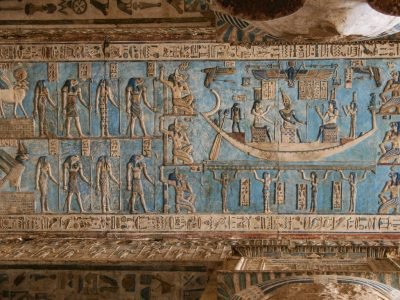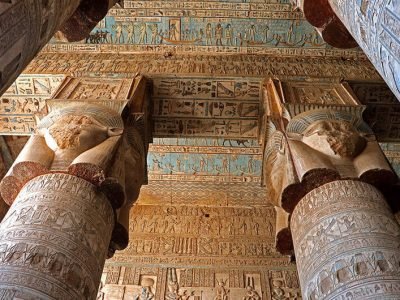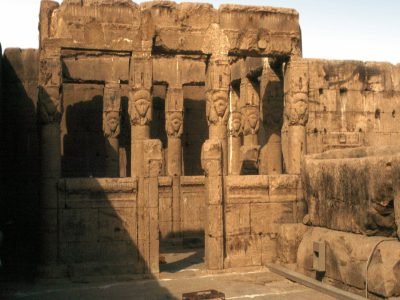z 0 recenzji
pełny dzień
Codzienna wycieczka
8 ludzie
Wszystkie języki

Wycieczka mini vanem Qena Dendera Temple Tour to podróż w czasie, gdzie mitologia, architektura i starożytna kosmologia zderzają się w jednym z najbardziej urzekających kompleksów historycznych w Egipcie. Przejazd tą trasą mini vanem zapewnia płynne, wygodne i spersonalizowane doświadczenie. Przemierzając krajobrazy Górnego Egiptu, aura sanktuarium Hathor zaczyna się ujawniać. To więcej niż wycieczka - to pielgrzymka do jednego z najbardziej duchowych miejsc w Egipcie.
Situated on the west bank of the Nile in Qena, about 60 km north of Luxor, Dendera is easily accessible via a 90-minute drive. The region is lush, historically rich, and less commercialized, offering a raw, authentic slice of Egyptian life. Qena itself is a cultural gem, rooted in traditional crafts and Coptic-Muslim coexistence.

Poświęcona Hathor, bogini miłości, muzyki, macierzyństwa i radości, świątynia Dendera jest jednym z najlepiej zachowanych kompleksów świątynnych w Egipcie. Dzięki żywym kolorom sufitów, astronomicznym rzeźbom i świętym komnatom, oferuje wgląd w egipską religię, która poprzedza nawet niektóre piramidy.
Wielkość świątyni jest niewątpliwa - jej masywne kolumny mają wygrawerowane kapitele w kształcie Hathor i pokryte są hieroglifami. Sufit sali hypostylowej zawiera sceny astronomiczne, w tym słynny zodiak z Dendery. Zejdź do krypt, aby zobaczyć święte płaskorzeźby przedstawiające tajemnicze urządzenia, które fascynowały zarówno egiptologów, jak i mistyków.
Wybór minivana na podróż zapewnia elastyczność, szybkość i intymność. W przeciwieństwie do dużych autobusów, minivan porusza się szybko i pozwala na spontaniczne postoje na zdjęcia lub eksplorację. Jest idealny dla mniejszych grup lub prywatnych wycieczek, oferując klimatyzację, wygodne siedzenia i lokalnego kierowcę, który zna najlepsze trasy widokowe.

Trasa z Luksoru lub Hurghady do Qeny to malownicza przejażdżka przez wioski nad Nilem, pola trzciny cukrowej i gaje palm daktylowych. Spodziewaj się zobaczyć bawiące się dzieci, rolników przy pracy i ponadczasowy rytm wiejskiego Egiptu. To kulturowe zanurzenie jeszcze przed dotarciem do bram świątyni.
Qena oferuje wgląd w codzienne egipskie życie poza szlakiem turystycznym. Tradycyjny strój, tętniące życiem rynki i ciepła gościnność czekają. Miasto słynie z ceramiki, produktów daktylowych i autentycznej egipskiej kuchni - warto je zwiedzić, jeśli pozwala na to harmonogram.
Kompleks Dendera był głównym ośrodkiem religijnym w okresie faraońskim, greckim i rzymskim. Odbywały się w nim coroczne festiwale, opieka medyczna w sanatorium i święte jezioro do rytualnego oczyszczania. Kalendarz świątynny, wyrównany z Syriuszem, ujawnia zaawansowaną wiedzę astronomiczną Egipcjan.
Oprócz głównej świątyni Hathor, kompleks obejmuje dom narodzin (mammisi), święte jezioro, chrześcijańską bazylikę, rzymską bramę i sanatorium. Struktury te opowiadają o warstwach historii i transformacji, pokazując znaczenie Dendery przez wieki użytkowania i czci.
Wewnątrz sanktuarium znajdują się sceny przedstawiające faraona składającego dary Hathor, bogini nieba Nut górującej nad światem, a także komnaty Ozyrysa ozdobione żywymi obrazami rytualnymi. Zodiak z Dendery, który niegdyś znajdował się tutaj, obecnie znajduje się w Luwrze - ale jego replika nadal budzi podziw.
Wiele wycieczek zapewnia doświadczonych egiptologów, którzy wyjaśniają nie tylko to, co widzisz, ale także głębsze znaczenie każdego symbolu i komnaty. Ich opowieści przekształcają ruiny w tętniący życiem gobelin mitów, rytuałów i starożytnej mądrości.
Zwiedzanie wczesnym rankiem lub późnym popołudniem pozwala uniknąć upałów i tłumów turystów. Najlepsze miesiące to od października do kwietnia, kiedy temperatury są łagodne, a światło dzienne jest idealne do fotografowania i eksploracji.
Gra światła słonecznego na hieroglificznych ścianach tworzy hipnotyzujące efekty cienia. Uchwyć zbliżenia twarzy Hathor, panoramiczne ujęcia całego kompleksu lub artystyczne kąty z podziemnych krypt i kaplic na dachu. Zabierz ze sobą obiektyw szerokokątny, aby podziwiać dzieła sztuki na suficie.
Dendera jest uważana za jedną z najsilniejszych energetycznie świątyń w Egipcie. Podróżnicy New Age i duchowi poszukiwacze często medytują tutaj, przyciągani przez świętą geometrię i postrzegane uzdrawiające wibracje. Połączenie ciszy, światła i historii sprzyja głębokiej refleksji.
Wyobrażenia Hathor wzmacniają kobiety i celebrują kobiecość, muzykę, radość i płodność. Świątynia celebruje boską kobiecość poprzez swoją sztukę, rytuały i kobiecą ikonografię, co czyni ją szczególnie znaczącą dla kobiet i osób zainteresowanych duchowością bogini.
Niewielkie, ale fascynujące muzeum na terenie kompleksu prezentuje relikwie, narzędzia i starożytne instrumenty medyczne znalezione podczas wykopalisk. Zapewnia ono głębszy kontekst dla użytkowania świątyni i jej obecnego znaczenia.
Nosić wygodne buty i oddychającą odzież
Przynieś butelkowaną wodę i krem z filtrem przeciwsłonecznym
Noś przy sobie lokalną walutę na drobne zakupy
Przestrzeganie zasad dotyczących ubioru (preferowany skromny strój)
Naładuj wcześniej aparat i telefon komórkowy
Wycieczki grupowe są przyjazne dla budżetu i towarzyskie, podczas gdy prywatne wycieczki oferują elastyczność, dogłębną eksplorację i prywatność. Obie opcje mają swoje zalety - wybór zależy od celów podróży i budżetu.
Wielu odwiedzających opisuje świątynię Dendera jako „ukryty skarb” i „lepiej zachowaną niż wiele świątyń w Luksorze”. Podróżni są często oszołomieni kolorami na sufitach i dostępnością krypt i dachu - rzadkość w Egipcie.
Egipskie drogi są ogólnie bezpieczne dla turystyki, a operatorzy turystyczni przestrzegają standardowych protokołów bezpieczeństwa. Samochody dostawcze są regularnie kontrolowane, a na trasie dostępne są przystanki wypoczynkowe. Należy mieć przy sobie środek do dezynfekcji rąk i unikać picia wody z kranu.
Małe stragany w pobliżu wejścia sprzedają ręcznie robione pamiątki, kadzidła, alabastrowe posągi i papirusowe dzieła sztuki. Targowanie się jest powszechne, a zakupy bezpośrednio wspierają lokalnych rzemieślników.
Zodiak i płaskorzeźby „żarówek” z Dendery stały się pożywką dla książek, filmów dokumentalnych i teorii na temat starożytnej technologii. Od „Starożytnych kosmitów” po czasopisma akademickie, świątynia ta nadal wywołuje intrygi i debaty naukowe.
Czy świątynia jest dostępna dla wózków inwalidzkich?
Nie w pełni. Główna świątynia jest częściowo dostępna, ale krypty i dachy wymagają schodów.
Jak długo trwa wycieczka z Luksoru?
Mniej więcej 90 minut w jedną stronę, co czyni ją idealną pół- lub całodniową wycieczką.
Czy zdjęcia są dozwolone?
Tak, zachęcamy do robienia zdjęć. Lampa błyskowa jest dozwolona z wyjątkiem określonych stref.
Czy mogę zwiedzać świątynię na własną rękę?
Tak, ale przewodnik znacznie wzbogaca doświadczenie.
Czy miejsce jest zatłoczone?
Nie. W porównaniu do świątyń w Luksorze, Dendera jest spokojniejsza i mniej skomercjalizowana.
Wycieczka Qena Dendera Temple Tour by Mini Van to urzekająca podróż przez duchowe i artystyczne dziedzictwo Egiptu. Od budzącej respekt świątyni Hathor po komfortową wycieczkę samochodową z przewodnikiem, ta wycieczka płynnie łączy wygodę, tajemnicę i głębię kulturową. Niezależnie od tego, czy jesteś miłośnikiem historii, poszukiwaczem duchowości, czy zwykłym odkrywcą, Dendera pozostawi trwały ślad na twojej duszy.
Zostaw recenzję